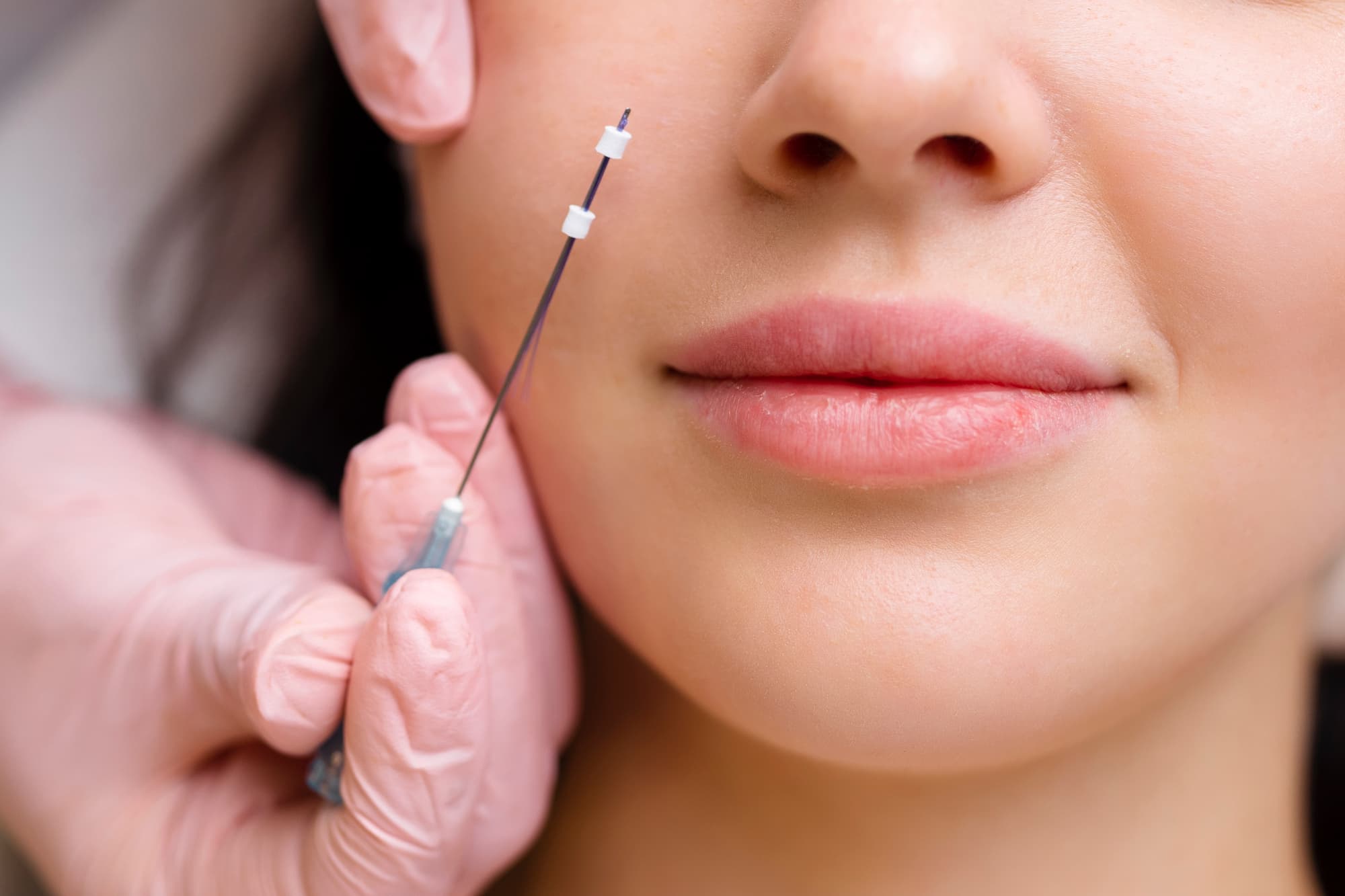
The ability to turn back the clock and reclaim our once-youthful features fascinates humans. One technique that has become increasingly popular in recent years is thread lift—a non-surgical procedure that aims to lift and tighten the skin. As with any cosmetic procedure, it’s essential to understand the risks and challenges of thread lifts. In this article, we will look at the potential advantages and disadvantages of thread lift, highlight the important aspects that medical professionals need to be aware of when considering this treatment option, and provide some alternatives for your patients.
How Thread Lifting Works
Before we get to the advantages and disadvantages, let’s refresh our knowledge with the basics.
Thread lift is a non-surgical procedure that uses sutures to slightly “lift” the skin, pin it in place, and provide structural support to the skin. This procedure stimulates the body’s natural healing response by promoting collagen and hyaluronic acid production in the treated area along the suture lines, further enhancing the procedure’s effectiveness. Collagen protein and hyaluronic acid are essential for ensuring healthy, young-looking skin. In extreme cases of a lack of skin volume, cosmetic fillers containing hyaluronic acid, like Radiesse, can be used to improve appearance.
This procedure presents itself as an interesting alternative to facelifting. Instead of simply removing the skin, it delicately lifts the existing skin a few millimeters and temporarily prevents any sagging. Both procedures are temporary, with thread lifting having shorter longevity. On average, it lasts several months to three years, while a facelift can last up to ten years. This is one of the main disadvantages of a thread lift compared to a surgical facelift, but it’s still a preferable option for patients who don’t want to undergo surgery.
There are three different types of suture threads used for the procedure: polydioxanone (PDO), polylactic acid (PLA), and polycaprolactone (PCA). The three differ in their longevity before the body breaks them down, as well as their capacity to stimulate collagen and hyaluronic acid production. They also come in various lengths, thicknesses, and shapes. Some are simple threads, while others have hooks to catch on and lift the skin better. The concept of hooks may initially intimidate patients, but there is no distinction between regular and barbed sutures regarding pain.
Advantages of Thread Lifts
We can’t talk about the risks of thread lift without mentioning its advantages. They are as follows:
Non-surgical: Thread lift is a non-surgical procedure that does not require incisions or the extensive downtime typically associated with surgical facelifts.
Minimally invasive: This procedure involves making tiny incisions to insert threads beneath the skin. This approach reduces scarring and allows for faster healing compared to traditional facelift surgery.
Natural-looking results: Thread lifts can provide natural-looking results by lifting and repositioning sagging facial tissues, resulting in a more youthful and rejuvenated appearance.
Collagen stimulation: The insertion of threads stimulates the skin’s natural production of collagen, which helps maintain skin elasticity and firmness over time.
Customizable treatment: Thread lifts offer customization based on the unique requirements and goals of each patient, with the ability to focus on particular problem areas like the cheeks, jawline, or brows.
Immediate effects: While the full results develop over time, as collagen production increases, patients may notice an immediate improvement in their facial appearance after the procedure.
Minimal downtime: Unlike surgical facelifts, thread lifts require less downtime, allowing patients to resume their daily activities sooner.
Disadvantages of Thread Lift
While we already mentioned one of the major disadvantages, it’s not the only one. There are other risks and complications involved in the process.
Side Effects
Before the patient consents to the treatment, several side effects associated with the thread lift procedure must be considered.
The most common side effects are:
- Bruising
- Swelling
- Redness
Although they are typical side effects of almost any medical procedure, many patients are surprised when experiencing them, hence the importance of clearly explaining all potential side effects before the treatment. They can last up to several weeks before the skin returns to normal.
Other, more severe, thread lift complications include:
Infection: Thread lift procedures carry a small but real risk of infection. Proper sterile techniques and post-treatment care can help minimize this risk.
Allergic reactions: Some individuals may be allergic to the materials used in thread lift procedures. Assessing the patient’s medical history and performing allergy testing, if necessary, is essential.
Poor results: Despite the potential benefits of thread lifting, there is a possibility of achieving suboptimal or unsatisfactory results. Factors such as individual variations in response to the procedure or improper technique can contribute to poor outcomes.
Pain: The entire procedure is done under topical anesthesia and is well tolerated by patients. Pain can be felt after the procedure if the thread is placed awkwardly or too tightly, causing pain and discomfort.
Dimpling: In some cases, thread-lifting complications can lead to the formation of visible dimples or irregularities in the treated area. This can occur due to the placement or movement of the threads beneath the skin.
Thread Protrusion: Thread protrusion occurs when the threads used in the procedure become visible or palpable under the skin. This can happen if the threads are not correctly placed or shift from their original position, leading to their visibility or palpability.
Nerve damage: There is a potential risk of nerve injury during the thread lift procedure, which can cause temporary or, rarely, permanent nerve damage. To reduce this risk, careful technique and precise thread placement are essential.
Body rejection: Although thread lift materials are generally well-tolerated by the body, there is a small possibility of the body rejecting the threads. This can lead to complications like inflammation, persistent redness, or delayed healing.
Not Suitable for Every Patient
While thread lifting has pros and cons, it’s important to consider that it may not be suitable for everyone. Several factors come into play, including skin type, lifestyle habits, age, and underlying health conditions. These factors can significantly impact the effectiveness and outcome of the procedure.
Thread lift treatment will not be beneficial for patients with excessive skin sagging, such as those who have lost a significant amount of weight. In such cases, alternative procedures like surgical facelifts may be more appropriate. Thread lift is most beneficial to people in their mid-30s to early 50s who have recently noticed signs of sagging.
Short-lived Results
As we mentioned before, the main disadvantage of thread lift is the longevity of the results. While the procedure provides immediate lifting and tightening effects, these outcomes are not permanent. Unlike surgical facelifts, which offer longer-lasting results, thread lift results are temporary. Various elements, including the patient’s age, skin condition, and lifestyle choices, can affect how long the effects last. On average, thread lift results may last from several months to a couple of years. Regular maintenance treatments may be required to sustain the desired appearance over time.
Thread Lift Considerations
When determining who is a good candidate for thread lift, there are several things medical professionals should consider before allowing patients to undergo the treatment and avoid the worst of thread lift complications. Those things are:
Current health: Evaluate the patient’s overall health to ensure they are in a suitable condition for thread lift.
Medical history: Review the patient’s medical history to identify any previous surgeries, known allergies, or underlying health conditions that may impact their eligibility for a thread lift.
Patient expectations: Discuss and manage patient expectations regarding the potential outcomes of thread lift. Manage their expectations by providing realistic information about what can be achieved through thread lift and discussing alternative or additional treatment options if necessary.
Skin type: Assess the patient’s skin type to determine the effectiveness of thread lift treatment for their specific skin characteristics. Consider factors such as skin elasticity, thickness, and any pre-existing skin conditions.
Age: While thread lift can benefit patients across different age groups, it is crucial to thoroughly evaluate the condition of the patient’s skin, degree of sagging, and underlying tissues to determine their suitability for the procedure.
Lifestyle habits: Evaluate the patient’s lifestyle habits and emphasize the importance of being close to their ideal weight for optimal results.
Alternatives to Thread Lift
If the disadvantages of thread lifting outweigh the benefits for the patient, or if the patient has unrealistic goals, it is essential to consider alternative treatments or a combination of multiple procedures.
Surgical facelift: A traditional surgical procedure that removes excess skin and tightens underlying tissues to achieve a youthful appearance. This is an excellent alternative for people with severe cases of saggy skin who don’t mind undergoing surgery.
Dermal Fillers: A non-invasive procedure that can add lift and volume and reduce wrinkles and fine lines in specific areas of the face. While dermal fillers alone may not provide significant facelift results, they can be combined with a thread lift procedure to enhance the overall outcome.
Ultrasound or radiofrequency treatments: These procedures stimulate collagen production, tightening skin and improving fine lines and wrinkles. They offer a surgery-free alternative for patients seeking natural-looking results.
Botox: Botox is a well-known muscle relaxant that does not provide any lift but effectively reduces the appearance of wrinkles and fine lines. It is a great enhancing procedure and is often sought after by patients.
Conclusion
We have now covered all the advantages and disadvantages of thread lift and its alternatives. By understanding the associated risks, challenges, and potential complications, you can make well-informed decisions, evaluate its suitability for your patients, and make recommendations that will contribute to the best possible outcomes for your patients. Your expertise is essential in guiding patients toward the most suitable procedures for their individual needs, and we are here to help you find whatever you need to achieve it.
FAQ
What are the adverse effects of thread lift?
Negative effects of thread lift can include bruising, swelling, redness, dimpling, pain, thread protrusion, and nerve damage.
How risky is a thread lift?
While there are potential risks and complications associated with thread lift procedures, such as nerve damage and body rejection, the overall risk level is low.
What are the downsides of face threads?
Face threads may cause complications, such as the appearance of dimpling where the threads are inserted, potential allergic reactions to the thread, and the risk of blood pooling.
References
- Long-term effect of the insoluble thread-lifting technique; Mototsugu Fukaya; Nov 2017
- Collagen Supplements for Aging and Wrinkles: A Paradigm Shift in the Fields of Dermatology and Cosmetics; Hend Al-Atif; Feb 2022
- Thread-Lift Sutures: Anatomy, Technique, and Review of Current Literature; Steven Halepas, Xun Joy Chen, and Elie M Ferneini; May 2020
- Minimally Invasive Techniques for Facial Rejuvenation Utilizing Polydioxanone Threads; Amit Kochhar, Parvesh Kumar, and Kian Karimi; Jul 2023
- Using PDO threads: A scarcely studied rejuvenation technique. Case report and systematic review; Candelaria Contreras, Amin Ariza-Donado, and Amin Ariza-Fontalvo; Apr 2023
- Two years’ outcome of thread lifting with absorbable barbed PDO threads: Innovative score for objective and subjective assessment; Yasser Helmy Ali; Dec 2017
- Facial thread lifting with suture suspension; Joana de Pinho Tavares, Carlos Augusto Costa Pires Oliveira, Rodolfo Prado Torres, and Fayez Bahmad Jr; Dec 2017
- Facial rejuvenation with fine-barbed threads: the simple Miz lift; Tae Hwan Park, Sang Won Seo, and Kwi Whan Whang; Jun 2013
- Barbed sutures “lunch time” lifting: evidence-based efficacy; Bishara S Atiyeh, Saad A Dibo, Michel Costagliola, and Shady N Hayek; Jun 2010
Injectable aesthetics are popular due to their ability to provide noticeable results with minimal downtime compared to surgical procedures. They are versatile and can be tailored to meet individual aesthetic goals, whether it's enhancing lips, restoring facial volume, or smoothing out wrinkles. However, they should always be administered by qualified professionals to ensure safety and achieve optimal results.
Injectable aesthetics are used to enhance facial features, reduce the signs of aging, and improve overall facial symmetry and appearance.
Key types of injectable aesthetics include:
-
Dermal Fillers: These injectables are used to add volume, fill in wrinkles and folds, and enhance facial contours. They often contain substances like hyaluronic acid, collagen, or calcium hydroxylapatite, which help plump up the skin and smooth out fine lines and wrinkles.
-
Botulinum Toxin (Botox): Botulinum toxin injections temporarily relax facial muscles that cause wrinkles and lines to form. It is commonly used to treat forehead lines, frown lines between the eyebrows, and crow's feet around the eyes.
-
Collagen Stimulators: These injectables stimulate the body's own collagen production, helping to improve skin texture and firmness over time. Examples include poly-L-lactic acid (Sculptra) and calcium hydroxylapatite (Radiesse).
-
Neurotoxin Injections: Besides Botox, other neurotoxins such as Dysport and Xeomin are used similarly to reduce wrinkles and lines.





